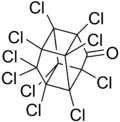
Back كلورديكون Arabic کپون AZB Klordekon Breton Clordecona Catalan Chlordecon Czech Chlordecon German Clordecona Spanish کپون Persian Klordekoni Finnish Chlordécone French

| |

| |
| Names | |
|---|---|
| IUPAC name
decachloropentacyclo[5.3.0.02.6.03.9.04.8]decan-5-one[1]
| |
| Other names
Chlordecone
Clordecone Merex CAS name: 1,1a,3,3a,4,5,5,5a,5b,6-decachlorooctahydro-1,3,4-metheno-2H-cyclobuta[cd]pentalen-2-one | |
| Identifiers | |
3D model (JSmol)
|
|
| ChEBI | |
| ChEMBL | |
| ChemSpider | |
| ECHA InfoCard | 100.005.093 |
| EC Number |
|
| KEGG | |
PubChem CID
|
|
| UNII | |
CompTox Dashboard (EPA)
|
|
| |
| |
| Properties | |
| C10Cl10O | |
| Molar mass | 490.633 g/mol |
| Appearance | tan to white crystalline solid |
| Odor | odorless |
| Density | 1.6 g/cm3 |
| Melting point | 349 °C (660 °F; 622 K) (decomposes) |
| 0.27 g/100 mL | |
| Solubility | soluble in acetone, ketone, acetic acid slightly soluble in benzene, hexane |
| log P | 5.41 |
| Vapor pressure | 3.10−7 kPa |
| Thermochemistry | |
Std molar
entropy (S⦵298) |
764 J/K mol |
Std enthalpy of
formation (ΔfH⦵298) |
-225.9 kJ/mol |
| Hazards | |
| Occupational safety and health (OHS/OSH): | |
Main hazards
|
carcinogen[2] |
| Flash point | Non-flammable[2] |
| Lethal dose or concentration (LD, LC): | |
LD50 (median dose)
|
95 mg/kg (rat, oral) |
| NIOSH (US health exposure limits): | |
PEL (Permissible)
|
none[2] |
REL (Recommended)
|
Ca TWA 0.001 mg/m3[2] |
IDLH (Immediate danger)
|
N.D.[2] |
Except where otherwise noted, data are given for materials in their standard state (at 25 °C [77 °F], 100 kPa).
| |
Chlordecone, better known in the United States under the brand name Kepone, is an organochlorine compound and a colourless solid. It is an obsolete insecticide, now prohibited in the western world, but only after many thousands of tonnes had been produced and used.[3] Chlordecone is a known persistent organic pollutant that was banned globally by the Stockholm Convention on Persistent Organic Pollutants in 2009.[4]
- ^ IUPAC Agrochemical information.
- ^ a b c d e NIOSH Pocket Guide to Chemical Hazards. "#0365". National Institute for Occupational Safety and Health (NIOSH).
- ^ Robert L. Metcalf "Insect Control" in Ullmann's Encyclopedia of Industrial Chemistry Wiley-VCH, Wienheim, 2002. doi:10.1002/14356007.a14_263
- ^ Press Release – COP4 – Geneva, 8 May 2009: Governments unite to step-up reduction on global DDT reliance and add nine new chemicals under international treaty, 2009.
© MMXXIII Rich X Search. We shall prevail. All rights reserved. Rich X Search